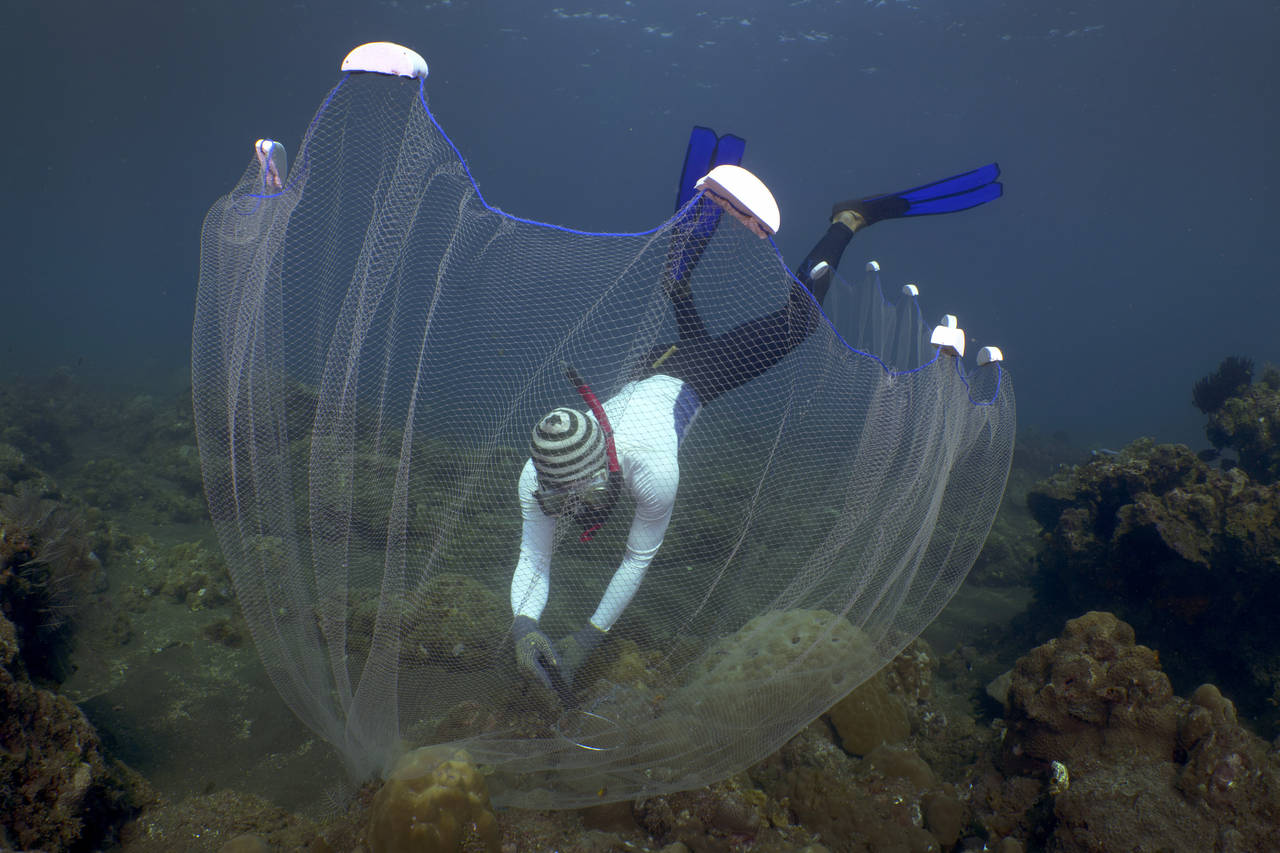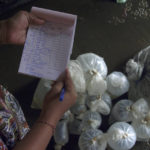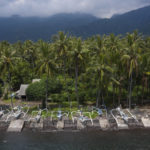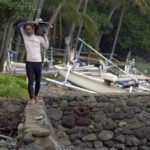Sparkling fish, murky methods: the global aquarium trade
Oct 18, 2022, 5:54 PM | Updated: Oct 19, 2022, 6:59 am

Made Partiana uses a net to catch aquarium fish on north coast of Bali, Indonesia, on April 10, 2021. Millions of saltwater fish are caught in Indonesia and other countries every year to fill ever more elaborate aquariums in living rooms, waiting rooms and restaurants around the world with vivid, otherworldly life. (AP Photo/Alex Lindbloom)
(AP Photo/Alex Lindbloom)
LES, Indonesia (AP) — After diving into the warm sea off the coast of northern Bali, Indonesia, Made Partiana hovers above a bed of coral, holding his breath and scanning for flashes of color and movement. Hours later, exhausted, he returns to a rocky beach, towing plastic bags filled with his darting, exquisite quarry: tropical fish of all shades and shapes.
Millions of saltwater fish like these are caught in Indonesia and other countries every year to fill ever more elaborate aquariums in living rooms, waiting rooms and restaurants around the world with vivid, otherworldly life.
“It’s just so much fun to just watch the antics between different varieties of fish,” said Jack Siravo, a Rhode Island fish enthusiast who began building aquariums after an accident paralyzed him and now has four saltwater tanks. He calls the fish “an endless source of fascination.”
But the long journey from places like Bali to places like Rhode Island is perilous for the fish and for the reefs they come from. Some are captured using squirts of cyanide to stun them. Many die along the way.
And even when they are captured carefully, by people like Partiana, experts say the global demand for these fish is contributing to the degradation of delicate coral ecosystems, especially in major export countries such as Indonesia and the Philippines.
There have been efforts to reduce some of the most destructive practices, such as cyanide fishing. But the trade is extraordinarily difficult to regulate and track as it stretches from small-scale fishermen in tropical seaside villages through local middlemen, export warehouses, international trade hubs and finally to pet stores in the U.S., China, Europe and elsewhere.
“There’s no enforcement, no management, no data collection,” said Gayatri Reksodihardjo-Lilley, founder of LINI, a Bali-based nonprofit for the conservation and management of coastal marine resources.
That leaves enthusiasts like Siravo in the dark.
“Consumers often don’t know where their fish are coming from, and they don’t know how they are collected,” said Andrew Rhyne, a marine biology professor at Roger Williams University in Rhode Island.
STUNNED BY CYANIDE
Most ornamental saltwater fish species are caught in the wild because breeding them in captivity can be expensive, difficult and often impossible. The conditions they need to reproduce are extremely particular and poorly understood, even by scientists and expert breeders who have been trying for years.
Small-scale collection and export of saltwater aquarium fish began in Sri Lanka in the 1930s and the trade has grown steadily since. Nearly 3 million homes in the U.S. keep saltwater fish as pets, according to a 2021-2022 American Pet Products Association survey. (Freshwater aquariums are far more common because freshwater fish are generally cheaper and easier to breed and care for.) About 7.6 million saltwater fish are imported into the U.S. every year.
For decades, a common fishing technique has involved cyanide, with dire consequences for fish and marine ecosystems.
Fishermen crush the blue or white pellets into a bottle filled with water. The diluted cyanide forms a poisonous mixture fishermen squirt onto coral reefs, where fish usually hide in crevices. The fish become temporarily stunned, allowing fishermen to easily pick or scoop them from the coral.
Many die in transit, weakened by the cyanide – which means even more fish need to be captured to meet demand. The chemicals damage the living coral and make it more difficult for new coral to grow.
LAX ENFORCEMENT
Cyanide fishing has been banned in countries such as Indonesia and the Philippines but enforcement of the law remains difficult, and experts say the practice continues.
Part of the problem is geography, Reksodihardjo-Lilley explains. In the vast archipelago of Indonesia, there are about 34,000 miles (54,720 kilometers) of coastline across some 17,500 islands. That makes monitoring the first step of the tropical fish supply chain a task so gargantuan it is all but ignored.
“We have been working at the national level, trying to push national government to give attention to ornamental fish in Indonesia, but it’s fallen on deaf ears,” she said.
Indonesian officials counter that laws do exist that require exporters to meet quality, sustainability, traceability and animal welfare conditions. “We will arrest anyone who implements destructive fishing. There are punishments for it,” said Machmud, an official at Indonesia’s marine affairs and fisheries ministry, who uses only one name.
“NO REAL RECORD-KEEPING”
Another obstacle to monitoring and regulating of the trade is the quick pace that the fish can move from one location to another, making it difficult to trace their origins.
At a fish export warehouse in Denpasar, thousands of fish a day can be delivered to the big industrial-style facility located off a main road in Bali’s largest city. Trucks and motorbikes arrive with white Styrofoam coolers crammed with plastic bags of fish from around the archipelago. The fish are swiftly unpacked, sorted into tanks or new plastic bags and given fresh sea water. Carcasses of ones that died in transit are tossed into a basket or onto the pavement, then later thrown in the trash.
Some fish will remain in small rectangular tanks in the warehouse for weeks, while others are shipped out quickly in plastic bags in cardboard boxes, fulfilling orders from the U.S., Europe and elsewhere. According to data provided to The Associated Press by Indonesian government officials, the U.S. was the largest importer of saltwater aquarium fish from the country.
Once the fish make the plane ride halfway around the world from Indonesia to the U.S., they’re checked by the Fish and Wildlife Service, which cross-references the shipment with customs declaration forms.
But that’s designed to ensure no protected fish, such as the endangered Banggai Cardinal, are being imported. The process cannot determine if the fish were caught legally.
A U.S. law known as the Lacey Act bans trafficking in fish, wildlife, or plants that were illegally taken, possessed, transported, or sold – according to the laws in the country of origin or sale. That means that any fish caught using cyanide in a country where it’s prohibited would be illegal to import or sell in the U.S.
But that helps little when it’s impossible to tell how the fish was caught. For example, no test exists to provide accurate results on whether a fish has been caught with cyanide, said Rhyne, the Roger Williams marine biology expert.
“The reality is that the Lacey Act isn’t used often because generally there’s no real record-keeping or way to enforce it,” said Rhyne.
LOCAL RESPONSE
In the absence of rigorous national enforcement, conservation groups and local fishermen have long been working to reduce cyanide fishing in places like Les, a well-known saltwater aquarium fishing town tucked between the mountains and ocean in northern Bali.
Partiana started catching fish – using cyanide — shortly after elementary school, when his parents could no longer afford to pay for his education. Every catch would help provide a few dollars of income for his family.
But over the years Partiana began to notice the reef was changing. “I saw the reef dying, turning black,” he said. “You could see there were less fish.”
He became part of a group of local fishermen who were taught by a local conservation organization how to use nets, care for the reef and patrol the area to guard against cyanide use. He later became a lead trainer for the organization, and has trained more than 200 fellow aquarium fishermen across Indonesia in use of less harmful techniques.
Reksodihardjo-Lilley says it this type of local education and training that should be expanded to reduce harmful fishing. “People can see that they’re directly benefitting from the reefs being in good health.”
For Partiana, now the father of two children, it’s not just for his benefit. “I hope that (healthier) coral reefs will make it possible for the next generation of children and grandchildren under me,” He wants them to be able to “see what coral looks like and that there can be ornamental fish in the sea.”
A world away in Rhode Island, Siravo, the fish enthusiast, shares Partiana’s hopes for a less distructive saltwater aquarium industry.
“I don’t want fish that are not collected sustainably,” he says. “Because I won’t be able to get fish tomorrow if I buy (unsustainably caught fish) today.”
___
Associated Press video journalist Kathy Young reported from New York. Marshall Ritzel contributed to this report from Rhode Island. Edna Tarigan contributed from Jakarta.
___
Follow Victoria Milko on Twitter: @thevmilko
___
The Associated Press Health and Science Department receives support from the Howard Hughes Medical Institute’s Department of Science Education. The AP is solely responsible for all content.
Copyright © The Associated Press. All rights reserved. This material may not be published, broadcast, rewritten or redistributed.



![Made Partiana looks at sea urchins in a tank in the LINI center in Les, Bali, Indonesia, on April 12, 2021. “I hope that [healthier] coral reefs will make it possible for the next generation of children and grandchildren under me,” Partiana says. He wants them to be able to “see what coral looks like and that there can be ornamental fish in the sea.” (AP Photo/Alex Lindbloom)](https://mynorthwest.com/wp-content/uploads/2022/10/ap_6cb83c7f91964f7fb7d673b987678eae-150x150.jpg)










![Made Partiana and another villager sort fish caught during the day on April 11, 2021. “I hope that [healthier] coral reefs will make it possible for the next generation of children and grandchildren under me,” Partiana says. He wants them to be able to “see what coral looks like and that there can be ornamental fish in the sea.” (AP Photo/Alex Lindbloom)](https://mynorthwest.com/wp-content/uploads/2022/10/ap_57137b776d98490db47ccbb5a5513b0e-150x150.jpg)















